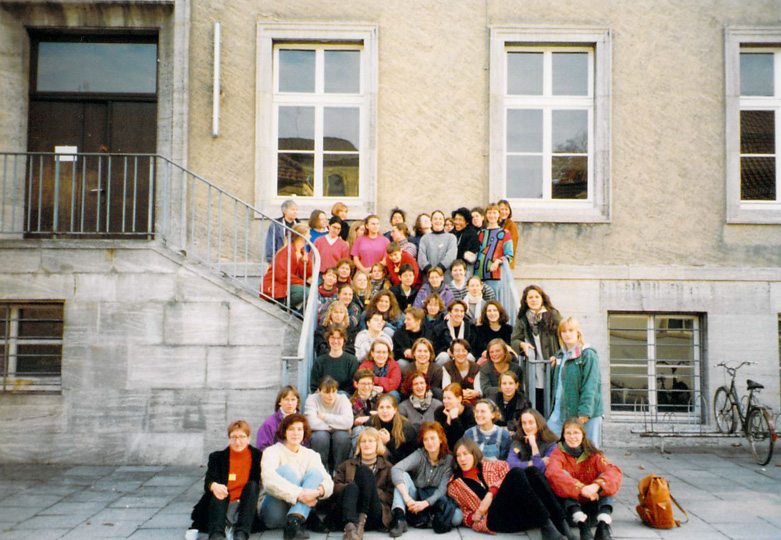History of the Deutschen Physikerinnentagung
The German Conference of Women Physicists (DPT) is an event that has been held since 1997. The conference offers female physicists from various disciplines and all career levels - from students to professors as well as industrial physicists - the opportunity for networking and professional exchange.
Elsa Neumann was the first woman in Germany to be allowed to study physics - at that time with exceptional permission. She passed her doctoral examination with flying colors in Berlin in 1899. More than a hundred years have passed since then, during which women have asserted themselves in this male domain. But women are still underrepresented in physics. Once a year, however, this situation changes - when Germany's female physicists meet.

"Physikerinnentreffen", Göttingen 1995
As early as the nineteen-nineties, there were women physicists who organized regular meetings at which physics topics were presented and discussed on societal issues. In Berlin, such a meeting was first declared the German Women Physicists' Conference in 1997. There, an initiative was launched to establish a representation of the interests of women physicists within the German Physical Society (DPG) and to support the Physikerinnentagung annually from then on. One year later, in 1998, the Physikerinnentagung was held in Hamburg. At the end of the meeting, the then president of the DPG, Alexander Bradshaw, confirmed the establishment of the Equal Opportunities Working Group (AKC) of the German Physical Society. Since then, among other things, the AKC has supported the annual meeting of women physicists, which is attended by an average of 250 women physicists. From 1997 to 2005, as well as in 2019 and 2020, the Physikerinnentagung took place without the participation of the DPG. From 2006 to 2018 and now again from 2021, the DPT is held as a DPG meeting.
Since the DPT 2011, physics lectures by men have been admitted in a pilot project. The proportion of presentations by men is based on the average quota of invited female speakers at the DPG spring conferences of the respective year. The German Meeting of Women Physicists is a forum for women in physics. It offers physicists the opportunity to get to know the fascinating research areas and career paths of the invited top-class female scientists, but also to present their own research. Professional perspectives are presented and experiences exchanged in workshops and panel discussions. The program is often supplemented by a series of events aimed at schoolgirls. Another important task of the conference is to promote contact between young female physicists and industry. To this end, female physicists from industry are invited to take an active part in the conference and to share what their everyday working life is like.
All women who feel connected to physics - whether they are pupils or students, lecturers, researchers, teachers or physicists in industry and business - are invited to participate in the conference, as well as men who feel connected to the goals of the conference. In this way, networks can be actively established to advance Germany as a center of science.
The situation of female physicists is still regularly reflected at the Physikerinnentagung. In 1990, the percentage of female professors in physics was only 0.7%. The probability of encountering female role models during one's studies was very low. That has improved in the meantime. But equal access to science and industry for all career stages has not yet been achieved. Despite all efforts and successes in recent years, the female share of professionals in STEM professions is still too low. To counteract this and to find ways to promote the compatibility of family and career, the German Conference of Women Physicists has been an integral part of the German scientific landscape for almost 25 years.
This year, we can look back on 25 conferences in 19 cities, all with a common goal. Nevertheless, each of the organizing teams has set focal points and highlights with its own style and character, which remain in the memory of the participants and make each of the conferences unique.
